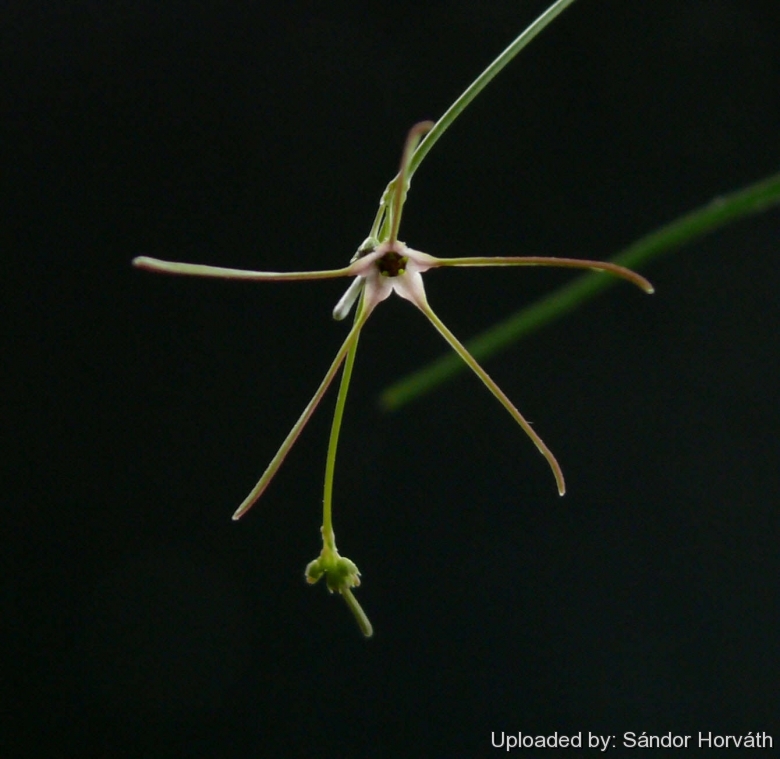




Your support is critical to our success.
Aloe 33(2–3): 43 (1996), without basionym date
Family: ASCLEPIADACEAE

Origin and Habitat: Brachystelma filifoliumSN|32319]]SN|32319]] is a dwarf geophyte herb with an aerial shoots up to 75 cm high, from a small flattish tuber (caudex) the top of which may sometimes be seen above ground. As the species name implies, the leaves are very thin grass-like and, if growing amongst grassy vegetation, they must be very hard to spot. It has inconspicuous but intensely fragrant flowers. Probably the most delicate of all species of Brachystelma.
Tuber (caudex): Round and flattened, mostly underground, 3-4.5 cm in diameter.
**Stem: Aerial shoot solitary, 45-75 cm high, slender, filiform, erect but apically mostly drooping, simple or sparingly branched at the middle, 1-5-2 mm thick at the base, glabrous.
Leaves: Sessile, arranged in an alternate or opposite position in 10–20 or more pairs, from below the middle to the apex of the stem, erect or ascending, the lower 3-8 cm long, c. 1 mm thick, the others gradually smaller, filiform, glabrous.
Inflorescences (racemes): Very slender glabrous, lateral at the nodes 1- to 2-flowered, sessile or shortly pedunculate, or clustered in branched terminal racemes, drooping. Lower racemes 7-10 cm long, occasionally branched, with 1–3 flowers at each of the 3–6 nodes, the upper much reduced. Bracts very minute. Pedicels 4–6(–8) mm long, filiform, glabrous.
Flowers: Sepals 1-1.5 mm long, lanceolate or ovate-lanceolate, acute, glabrous. Corolla quite glabrous, apparently greenish outside and purple-brown on the inner face of the lobes and sweetish-scented. Tube about 1.5 mm long, cup-shaped. Lobes ascending-spreading, 7-9 mm long, filiform from a deltoid-ovate base, folded back along the midrib. Corona almost sessile, shortly bowl-shaped, c. 1 x 1.3 mm, outside shortly hairy. Outer corona of 5 very minute prominent pouch-like, oval, ascending lobes. Inner corona-lobes 0.5 mm long, filiform, ascending, closely incumbent on the backs of the anthers and produced beyond them into connivent-erect tips, dark-coloured. Staminal column c 1.25 mm long. Pollinia ovoid, c. 0.18 mm.
Fruits (follicles):*** One or two per flower, diverging, about 6 cm long, 2.5 mm thick, linear-terete, beaked, glabrous.
Synonyms:
- Brachystelma filifolium (Schltr.) Peckover
- Macropetalum filifolium Schltr.
- Tenaris filifolia (Schltr.) N.E.Br.
Description: Brachystelma filifoliumSN|32319]]SN|32319]] is a dwarf geophyte herb with a thin aerial shoot up to 75 cm high, from a small flattish tuber (caudex) the top of which may sometimes be seen above ground. As the species name it implies, the leaves are very thin grass-like and, if growing amongst grassy vegetation, they must be very hard to spot. It has inconspicuous but intensely fragrant flowers. Probably the most delicate of all species of Brachystelma.
Tuber (caudex): Round and flattened, mostly underground, 3-4.5 cm in diameter.
Stem: Aerial shoot solitary, 45-75 cm high, slender, filiform, erect but apically mostly drooping, simple or sparingly branched at the middle, 1-5-2 mm thick at the base, glabrous.
Leaves: Sessile, arranged in an alternate or opposite position in 10–20 or more pairs, from below the middle to the apex of the stem, erect or ascending, the lower 3-8 cm long, c. 1 mm thick, the others gradually smaller, filiform, glabrous.
Inflorescences (racemes): Very slender glabrous, lateral at the nodes 1- to 2-flowered, sessile or shortly pedunculate, or clustered in branched terminal racemes, drooping. Lower racemes 7-10 cm long, occasionally branched, with 1–3 flowers at each of the 3–6 nodes, the upper much reduced. Bracts very minute. Pedicels 4–6(–8) mm long, filiform, glabrous.
Flowers: Sepals 1-1.5 mm long, lanceolate or ovate-lanceolate, acute, glabrous. Corolla quite glabrous, apparently greenish outside and purple-brown on the inner face of the lobes and sweetish-scented. Tube about 1.5 mm long, cup-shaped. Lobes ascending-spreading, 7-9 mm long, filiform from a deltoid-ovate base, folded back along the midrib. Corona almost sessile, shortly bowl-shaped, c. 1 x 1.3 mm, outside shortly hairy. Outer corona of 5 very minute prominent pouch-like, oval, ascending lobes. Inner corona-lobes 0.5 mm long, filiform, ascending, closely incumbent on the backs of the anthers and produced beyond them into connivent-erect tips, dark-coloured. Staminal column c 1.25 mm long. Poll ovoid, c. 0.18 mm.
Fruits (follicles): One or two per flower, diverging, about 6 cm long, 2.5 mm thick, linear-terete, beaked, glabrous.
Bibliography: Major references and further lectures
1) Focke Albers, Ulrich Meve “Illustrated Handbook of Succulent Plants: Asclepiadaceae: Asclepiadaceae”, Volume 4 Springer Science & Business Media, 2002
2) N. E. Brown “Flora of Tropical Africa”, Vol 4, 1904
3) Kamundi, D.A. & Victor, J.E. 2005. “Brachystelma filifolium (N.E.Br.) Peckover.” National Assessment: Red List of South African Plants version 2015.1. Accessed on 2016/01/13
Cultivation and Propagation: In cultivation the plants are usually grown in semi shade, with the tubers wholly or (preferably) partially exposed to prevent scorching and rotting of the roots. This plant can take a good deal of water during active growth and should be watered only when not dormant. Keep dryish in winter. It should be overwintered in the greenhouse at temperatures over 15°C (avoid letting temperatures drop lower than 10° C). Use a very draining but rich soil. An error in cultivation may produce unsightly holes in the tuber.
Reproduction: This species can be reproduced by seeds. Sow seeds in summer in a well drained medium.
| Your Actions | |
|---|---|
| Back to Brachystelma index | |
| Back to Asclepiadaceae index | |
 |
Back to Succulents Encyclopedia index |
Privacy stantement - Terms and conditions - How to cite - About us - Feedback - Donate




